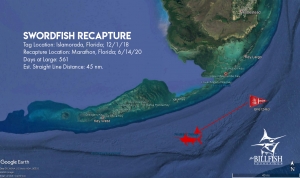
The most important data received through TBF’s Tag & Release Program is recapture data. A recapture occurs when a tagged billfish is caught by a second angler subsequent to the tagging and release of a fish. Recapture data contributes toward gaining a better understanding of the species age and growth rates by comparing the reported estimated weight at the time of tagging with the estimated weight upon recapture with consideration given to the amount of time between the two events. Recapture data also contributes to understanding a species possible site or area fidelity, if tagged and recaptured in the same area. Site fidelity often indicates the possibility of a critical life stage event occurring in the region, like spawning. Also, the highly migratory nature of marlin is often confirmed with long distance tag recaptures, and the data also contributes to the understanding of post release survivability.
During the first 6 months of 2020, 33 recaptures were reported, which is lower than previous years, attributed likely to reduced fishing effort due to COVID-19. Of the 33, 18 sailfish and 6 swordfish were tagged and recaptured in South Florida, with others in France, Costa Rica, Japan and Australia. Thank you to our Tag & Release Program Sponsors; Garmin, Yeti, Costa Del Mar, King Sailfish Mounts, Casa Vieja Lodge, and the International Game Fish Tournament Observers.
JANUARY
January included 8 sailfish and 2 swordfish recaptures off South Florida and 1 black marlin recapture off Australia, all occurring within the regions where tagged. The fish at-large the longest, 799 days, a sailfish, recaptured within 3 nautical miles from where tagged was reported to have gained an estimated 15 pounds. A second sailfish, at-large for 703 days, was recaptured within 3 nautical miles. A third recaptured sailfish, at-large for 429 days, had a reported weight gain of an estimated 10 pounds with a fourth fish having no reported size change over 28 days.
[av_slideshow size=’no scaling’ control_layout=’av-control-default’ conditional_play=” animation=’slide’ transition_speed=” autoplay=’false’ interval=’5′ alb_description=” id=” custom_class=” av_uid=’av-gfhalb’]
[av_slide id=’9936′ av_uid=’av-dj95fj’][/av_slide]
[av_slide id=’9938′ av_uid=’av-d0cmz3′][/av_slide]
[av_slide id=’9940′ av_uid=’av-ax4iov’][/av_slide]
[av_slide id=’9941′ av_uid=’av-9w4n5r’][/av_slide]
[av_slide id=’9942′ av_uid=’av-p8ka7′][/av_slide]
[av_slide id=’9943′ av_uid=’av-5vo0xr’][/av_slide]
[av_slide id=’9944′ av_uid=’av-3y1t67′][/av_slide]
[av_slide id=’9946′ av_uid=’av-34ef8v’][/av_slide]
[/av_slideshow]
The first swordfish recapture, at-large 870 days, longer than any of the January recaptures, was recaptured 165 nautical miles from where tagged in August with a tripling weight gain reported from 25 to 80 pounds. The second swordfish recapture, at-large just less than 2 years, recaptured within 4 nautical miles, was reported to have increased in length from 30 to 60 inches.
The black marlin, recaptured off Australia in January, at-large 339 days and recaptured within 9 miles of where tagged, had an estimated 20-pound weight gain.
[av_slideshow size=’no scaling’ control_layout=’av-control-default’ conditional_play=” animation=’slide’ transition_speed=” autoplay=’false’ interval=’5′ alb_description=” id=” custom_class=” av_uid=’av-fv4p4v’]
[av_slide id=’9939′ av_uid=’av-dki5sv’][/av_slide]
[av_slide id=’9937′ av_uid=’av-cp89e7′][/av_slide]
[/av_slideshow]

FEBRUARY
Five sailfish recaptures, all tagged off South Florida, were reported in February, with 3 remaining in the region, the fourth off Mexico and the fifth off Costa Rica. All recaptures, within 60 nautical miles of where tagged, were at-large from a little less than a year to over 4 years. Only one had a reported growth increase, 7 inches in length.
One swordfish, tagged and released off South Florida in September, recaptured in February off Cuba, 150 nautical miles from where tagged, traveled 2.5 times further than the sailfish.
[av_slideshow size=’no scaling’ control_layout=’av-control-default’ conditional_play=” animation=’slide’ transition_speed=” autoplay=’false’ interval=’5′ alb_description=” id=” custom_class=” av_uid=’av-agmt8f’]
[av_slide id=’9986′ av_uid=’av-9wy09b’][/av_slide]
[av_slide id=’9987′ av_uid=’av-6w9r7j’][/av_slide]
[av_slide id=’9988′ av_uid=’av-5iamov’][/av_slide]
[av_slide id=’9989′ av_uid=’av-45hq8f’][/av_slide]
[av_slide id=’9990′ av_uid=’av-36kfvz’][/av_slide]
[/av_slideshow]

MARCH
Two swordfish recaptures included one at-large for 2 two years off South Florida, with an estimated 60-pound weight increase reported, was recaptured 103 nautical miles from where tagged.

The second recapture took place off Southern France, 5 nautical miles from where tagged after being at-large for approximately 6 months. It did not grow at all in that time, staying at an estimated 20kg.

APRIL
Two sailfish tagged off South Florida in December, one in 2017 and the second in 2019, were recaptured less than 100 nautical miles from where tagged, with the 2017 fish reported to have gained an estimated 20-pounds while at-large – 45 to 65 pounds.


A yellowfin tuna, tagged and recaptured within 31 nautical miles in Panama, was at-large approximately 1 year, during which a reported growth increase of 18 inches in length was reported.

The only striped marlin recapture was off Japan, 200 nautical miles from where tagged, at-large for 2.5 years and had a weight gain of 22 pounds reported.

MAY
Five tagged sailfish off South Florida and one swordfish were recaptured during the month. One sailfish, at-large for 3 years, and recaptured within 2 nautical miles from where tagged, had an estimated weight increase of 30 pounds – 40 pounds to 70 pounds. A second one, at large for 811 days, recaptured 88 nautical miles from where tagged, had an estimated growth increase from 40 to 84 inches in length. A third sailfish, at-large for 264 days, had no reported size changes. Two of the five sailfish recaptured did not have size estimates.
[av_slideshow size=’no scaling’ control_layout=’av-control-default’ conditional_play=” animation=’slide’ transition_speed=” autoplay=’false’ interval=’5′ alb_description=” id=” custom_class=” av_uid=’av-apnqrj’]
[av_slide id=’10003′ av_uid=’av-96i5a7′][/av_slide]
[av_slide id=’10004′ av_uid=’av-7h0pn3′][/av_slide]
[av_slide id=’10005′ av_uid=’av-5nxe2n’][/av_slide]
[av_slide id=’10006′ av_uid=’av-3t8ubj’][/av_slide]
[av_slide id=’10013′ av_uid=’av-2jkoi7′][/av_slide]
[/av_slideshow]
The swordfish, similar to the February swordfish recapture, tagged in the Northern Florida Keys, recaptured in Cuba, roughly 180 miles away, had a doubling in weight reported from an estimate of 50 pounds (48 inches) to 99 pounds (60 inches).

JUNE
Two yellowfin tuna, 1 swordfish and 1 blue marlin were recaptured in June. Both yellowfin tuna recaptures were off Louisiana and were at-large for very short periods. One at-large for 7 days was recaptured 7 nautical miles from where tagged. The second one at-large for 17 days was recaptured 24 nautical miles away. Neither were reported to have increased in size.


The blue marlin, recaptured 270 nautical miles from where it was tagged in the Gulf of Mexico, was at-large 296 days, and weighed nearly 400 pounds upon recapture.

The swordfish, tagged, released and recaptured within 45 nautical miles from where tagged in the Florida Keys, at-large for roughly 1.5 years, had an estimated growth increase from 45 pounds (46 inches) to 60 pounds (50 inches).

We at TBF appreciate the work fishing teams invest in reporting recapture data, it is the most valuable tagging data for scientists to use in age and growth research.
For more information on The Billfish Foundation’s Tag & Release Program, check out our website. Tagging equipment can be purchased at our online shop*. To stay up to date on all things billfish, become a member, subscribe to our monthly newsletter, and follow us on social media, @TheBillfishFoundation.
*Please note that if you are not in the United States, shipping is currently suspended due to COVID-19. Please email us at [email protected] for tagging equipment and we will assess whether shipping is available to your region on a case-by-case basis.






